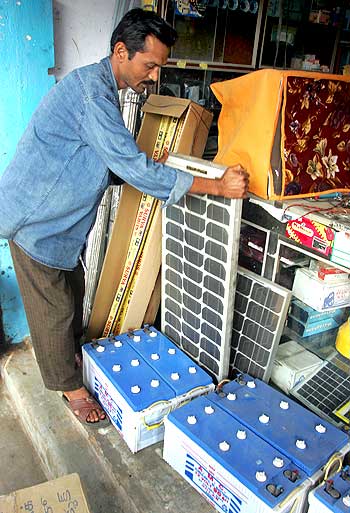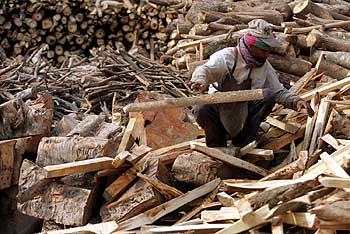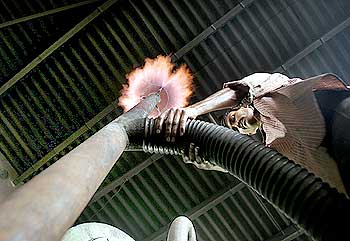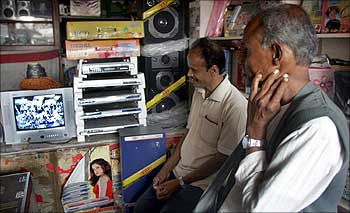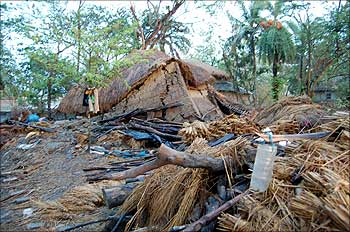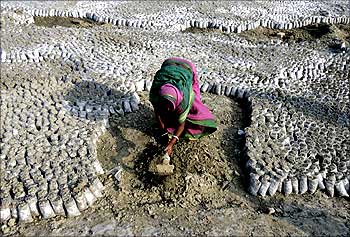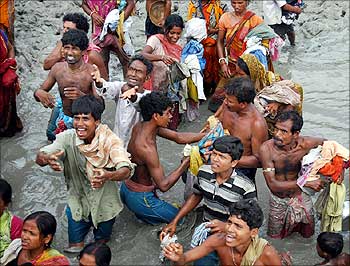 | « Back to article | Print this article |
Sunderbans: Where the sun shines on climate change
The Sunderbans boast the highest concentration of solar home panels in India thanks to the efforts of a former government scientific officer.
Sustainable technology may be the next big thing for India Inc, but for S P Gon Chaudhuri, it's been a reality for more than a quarter century.
Way back in 1983, long before Climate Change convulsed into a heated global debate, Gon Chaudhuri harnessed the power of the sun to make a giant leap for solar technology in India.
Sunderbans: Where the sun shines on climate change
Then a senior scientific officer in the Tripura government, Gon Chaudhuri started a small 100 watt solar photovoltaic irrigation and institutional solar lighting project in a tribal village that lacked grid connectivity.
Achieved under the radar and with little fanfare, that project turned out to be the first successful installation of solar photovoltaic technology in India.
Ten years later, as managing director of the West Bengal Green Energy Corporation, the state's nodal renewable energy agency, he has brought electricity to the island chain known as the Sunderbans.
Stuck in dense mangrove jungles in the Ganga delta this is tough terrain for pretty much any construction. Yet today, the islands boast the highest concentration of solar home panels in India.
Sunderbans: Where the sun shines on climate change
Since 1996-97 -- that is, in just 12-odd years -- more than 100,000 solar panels have been installed in the Sunderbans for which the government has spent just Rs 40 crore (Rs 400 million).
"About 10 years ago, solar power production cost Rs 30 crore (Rs 300 million) per Mw and has now fallen to Rs 10 crore (Rs 100 million) per Mw," says Gon Chaudhuri.
Though this is still significantly higher than the Rs 4 crore (Rs 40 million) per Mw for a conventional thermal power plant, Gon Chaudhuri says costs will start falling faster once solar power use achieves critical mass and as research progresses.
Since 1996-97 -- that is, in just 12-odd years -- more than 100,000 solar panels have been installed in the Sunderbans for which the government has spent just Rs 40 crore.
Sunderbans: Where the sun shines on climate change
As a result of Gon Chaudhuri's pioneering efforts, villagers in the Sunderbans are completely dependent on renewable energy, in the form of solar, wind or biomass and many say it has transformed their lives.
Take the case of 45-year old Murari Halder of Dakhin Mokhambariya, a village about 150 km from Kolkata.
About nine years ago, he bought a 75 watt solar panel for Rs 4,500. "The light has become a life-saver for my family and me. My son was able to complete his studies and is now doing his graduation in Kolkata -- all thanks to the solar panel," he said.
Sunderbans: Where the sun shines on climate change
Halder is not an isolated case. There are approximately 2,500 such solar panel houses in the village. More than 60,000 solar panels light up the lives of thousands.
Many like Halder have been using it for a decade. Sumita Maiti, for instance, is now a part of a local self help group and is able to work from home thanks to solar-powered electricity in her home.
Sunderbans: Where the sun shines on climate change
A couple of years ago, Subhash Mondol installed a 75 watt solar panel for Rs 18,000, which powers two or three lights every day and one TV for an hour or so.
Most villagers in Dakhin Mokhambariya have electricity for five to six hours continuously everyday and get to watch television twice a week or more -- indeed, a couple of DTH satellites could be spotted on rooftops.
Meanwhile, in nearby Basanti block there are approximately 2,500 users and on the other side of the river in Gosaba block, there are 5,000 solar users and 1,200 who use biomass power from a 500 kilowatt biomass power plant that WBGECL had set up, the first such plant in the country.
Sunderbans: Where the sun shines on climate change
The drawbacks mostly lie in the weather since the panels don't get enough sun to charge them. Gon Chaudhuri, however, said, "Ideally a 75 watt solar panel if fully charged can support three solar lights for a five-hour stretch and a TV for two hours but invariably most villagers don't know this."
Hurricane Aila did considerable damage to the solar panels and the state government is reviewing the extent of the damage. WBGECL plans to develop a package with the help of the Centre to restore the solar power system in the worst affected areas.
Villagers also complain that the government does not extend subsidies to install solar panels. Gon Chaudhuri explains that a Rs 4,800 crore (Rs 48 billion) subsidy was being given for the last two years, but has been rolled back owing to a change in the central government's "solar home system project".
Sunderbans: Where the sun shines on climate change
"The Union government is trying to introduce a modified cluster concept which is expected early next year, so there is a gap now. A new subsidy and project form is being developed," he adds.
Under the subsidy regime, WBGECL had shortlisted 19 companies to supply the solar panel set-up, each of which would get the subsidy in the name of the user (this partly explains why most villagers were unaware of the scheme). The subsidy scheme was designed to attract more companies into solar power business, Gon Chaudhuri explains.
WBGECL's Sunderban project has attracted considerable attention but Gon Chaudhuri has been able to replicate this solar lighting system in Leh, Jammu & Kashmir, Silchar, Mizoram as well as in neighbouring Bangladesh.
Sunderbans: Where the sun shines on climate change
He predicts that the future lies in renewable energy for purely practical reasons. "Thermal power will be phased out by 2050 because coal reserves will be exhausted," he says, adding,
"From a small 100 watt project in Tripura, the installed solar capacity in the country has grown to more than 100 Mw. Solar and nuclear power will be the primary energy forms by 2030-2040 in India."
